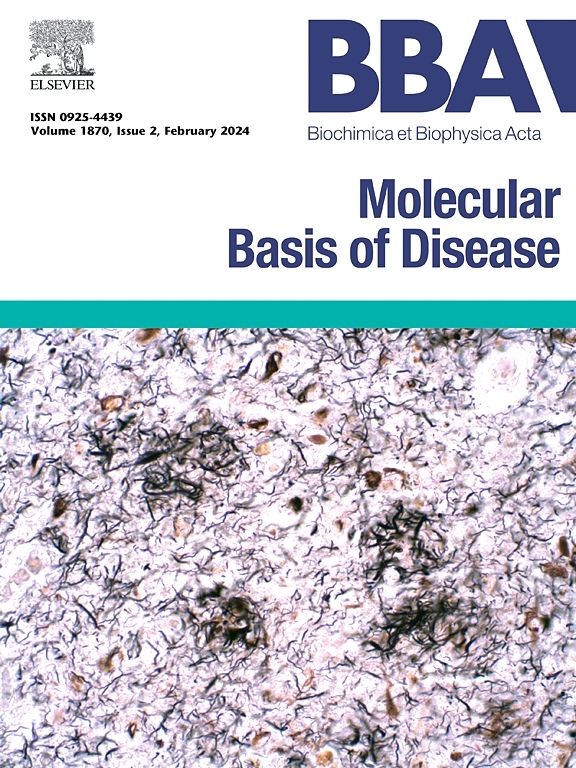Inosine from purine metabolism enhances fracture healing by coupling fibrinolysis and angiogenesis of type H vessels
IF 4.2
2区 生物学
Q2 BIOCHEMISTRY & MOLECULAR BIOLOGY
Biochimica et biophysica acta. Molecular basis of disease
Pub Date : 2025-03-28
DOI:10.1016/j.bbadis.2025.167818
引用次数: 0
Abstract
Fibrinolysis–angiogenesis coupling is crucial for successful fracture healing, in which type H vessels play an indispensable role. However, the metabolic control of fibrinolysis-type H angiogenesis coupling in fracture healing remains unclear. We used a metabolomics approach to gain metabolic insights from mouse fracture models (0.3 mm and 1.0 mm femur defects). Furthermore, human umbilical vein endothelial cells (HUVECs) and MC3T3-E1 cells were employed as in vitro models to examine the effects of identified metabolites on endothelial events and osteogenesis, respectively. CD31 and endomucin (Emcn) were used for detecting type H markers, and tissue-type plasminogen activator (tPA) and plasminogen activator inhibitor-1 (PAI-1) for fibrinolysis. A femur defect of 1.5 mm in mice was included to validate the therapeutic potential of identified metabolites by bone imaging and micro-CT. Purine metabolism is the most significant pathway in fracture healing; three purinergic metabolites, adenosine, adenine, and inosine, are regulated in mouse serum. According to the in vivo results, CD31HiEmcnHi type H vessels are upregulated near the defect site in mouse femur and are associated with tPA expression, but not PAI-1. Additionally, in vitro experiments examining the endothelial functions of HUVECs demonstrated that these three metabolites promote cell migration and tube formation rather than proliferation. Fibrinolytic activity and type H phenotype in HUVECs were induced only by inosine through activation of the adenosine A2A receptor. Inosine, regulated during fracture healing, has the capacity to synchronously induce fibrinolysis and type H phenotype in line with osteogenesis, indicating its role in enhancing fracture healing.

嘌呤代谢产生的肌苷通过耦合纤维蛋白溶解和H型血管生成促进骨折愈合。
纤维蛋白溶解-血管生成耦合是骨折成功愈合的关键,其中H型血管起着不可或缺的作用。然而,在骨折愈合过程中纤维蛋白溶解- H型血管生成耦合的代谢控制尚不清楚。我们使用代谢组学方法从小鼠骨折模型(0.3 mm和1.0 mm股骨缺损)中获得代谢见解。此外,采用人脐静脉内皮细胞(HUVECs)和MC3T3-E1细胞作为体外模型,分别检测鉴定的代谢物对内皮事件和成骨的影响。采用CD31和内膜蛋白(Emcn)检测H型标志物,采用组织型纤溶酶原激活物(tPA)和纤溶酶原激活物抑制剂-1 (PAI-1)检测纤溶酶。为了验证骨成像和微ct鉴定的代谢物的治疗潜力,我们纳入了小鼠股骨1.5 mm的缺损。嘌呤代谢是骨折愈合中最重要的途径;三种嘌呤能代谢产物,腺苷、腺嘌呤和肌苷,在小鼠血清中受到调节。体内实验结果显示,小鼠股骨缺损部位附近CD31HiEmcnHi型H血管表达上调,与tPA表达相关,而与PAI-1表达无关。此外,研究HUVECs内皮功能的体外实验表明,这三种代谢物促进细胞迁移和管形成,而不是增殖。仅肌苷通过激活腺苷A2A受体诱导HUVECs的纤溶活性和H型表型。肌苷在骨折愈合过程中受到调节,具有同步诱导纤维蛋白溶解和与成骨一致的H型表型的能力,表明其在促进骨折愈合中的作用。
本文章由计算机程序翻译,如有差异,请以英文原文为准。
求助全文
约1分钟内获得全文
求助全文
来源期刊
CiteScore
12.30
自引率
0.00%
发文量
218
审稿时长
32 days
期刊介绍:
BBA Molecular Basis of Disease addresses the biochemistry and molecular genetics of disease processes and models of human disease. This journal covers aspects of aging, cancer, metabolic-, neurological-, and immunological-based disease. Manuscripts focused on using animal models to elucidate biochemical and mechanistic insight in each of these conditions, are particularly encouraged. Manuscripts should emphasize the underlying mechanisms of disease pathways and provide novel contributions to the understanding and/or treatment of these disorders. Highly descriptive and method development submissions may be declined without full review. The submission of uninvited reviews to BBA - Molecular Basis of Disease is strongly discouraged, and any such uninvited review should be accompanied by a coverletter outlining the compelling reasons why the review should be considered.

 求助内容:
求助内容: 应助结果提醒方式:
应助结果提醒方式:


